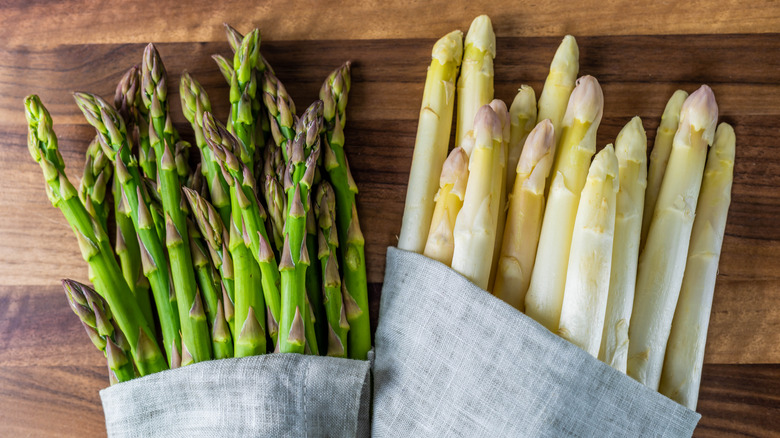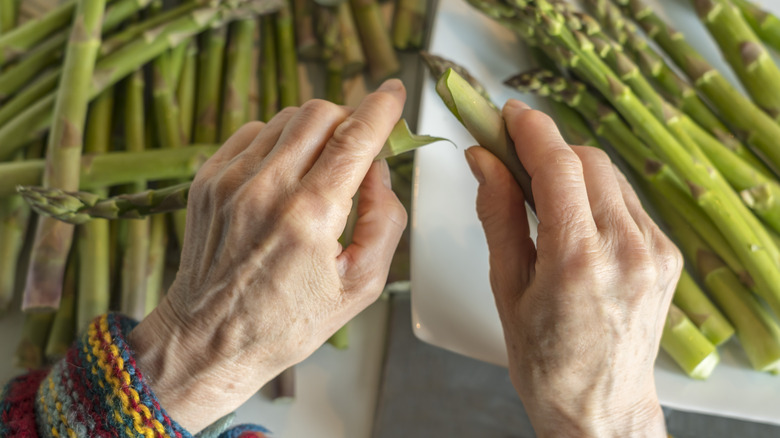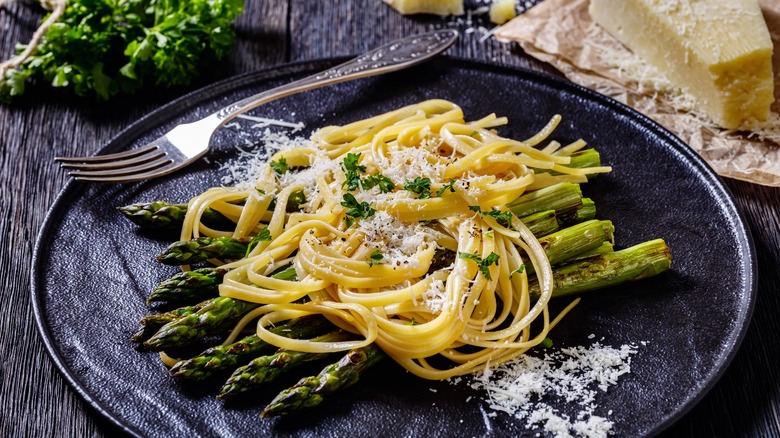The Easiest Way To Trim Asparagus Without A Knife
Seeing fresh asparagus start to show up at the market can be a thrill, signaling it's time to fire up the grill or break out your go-to seasonal salads. But, regardless if you're warming up the grates for the first time of the year or returning to your go-to recipe, there are some asparagus mistakes you might be making. One of the easiest faux pas to correct has to do with how you trim the spears, especially when you don't have a knife.
Whether you're preparing green asparagus or its white or purple counterparts, most varieties need to be trimmed of their tough, woody ends to make them palatable. The one exception are super thin stalks that are tender from top to bottom, as those don't tend to be as fibrous. For thicker ones, though, you'll want to remove the dense bottoms.
Thankfully, like some kind of gift from nature, asparagus has its own built-in, no-knife-required trick that makes removing the ends a snap — literally. All you have to do is hold a spear at both ends and gently bend it. You'll discover that there's an inherent breaking point conveniently located between the supple part and the hard base. By applying just a bit of pressure, the stalk will give at just the right place. That audible snap will yield you one piece that's topped with the delicate and delicious tip, and a rougher piece that you can use for other purposes, such as making broth.
How to snap asparagus spears by hand
The asparagus snapping hack is definitely convenient when using a knife is not available. For example, when you're camping or maybe having a BBQ at the beach. You can even snap a few spears at once, as there's no need to split them one at a time. There is one caveat, however, when it comes to this knife-less method — it can waste quite a bit of the usable parts of the vegetable.
A spear's natural snapping point varies depending on its thickness, how fresh it is, as well as where and how firmly you apply pressure. The downside of the easy knife-free technique is that you'll probably be trimming off more than necessary. Cook's Illustrated put this method to the test and found that snapping resulted in about 50% weight loss from the veggie, while cutting removed significantly less, not even 30%.
Still, knowing how to easily prep asparagus without the utensil is handy in a pinch, or for situations when all you need are the tips. As well, it's not as wasteful if you repurpose rather than discard the ends, and, like some of the odd asparagus etiquette people followed in the 1950s, some rules are made to be broken.
Zero-waste cooking with asparagus ends
If you do choose to use a knife and want to get the most out of your asparagus, start by chopping 1-2 inches off of the bottom of the veggie. On most green spears, there's usually a color difference between the coarse section and where the spear starts to turn bright green ... that's the sweet spot you want to aim for. If the inside above the cut appears moist and pliable, you're good to go. If it's still dry and hard, cut off a bit more until the texture changes. Fatter spears will also sometimes have a sinewy outer skin, which you can remove using a vegetable peeler.
Knife or no knife, you'll end up with a bunch of trimmed, woody asparagus bottoms. There's no need to discard these because they're still full of flavor and can be put to good use. For example, they can be frozen to use later, either on their own or with other vegetable peelings, to make into a nutritious homemade stock.
The trimmings can also be used along with their tops in a spring asparagus soup recipe. Simmering the tips for around 20 minutes will impart their flavor and then they can be strained out. Alternately, the woody ends can be pureed in a food processor or blender with some oil (the machine's blades will help to break them down) and be used as the star ingredient in soup along with some cream and butter for a smooth finish.



